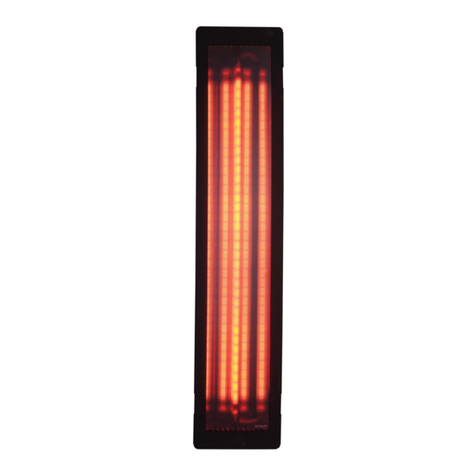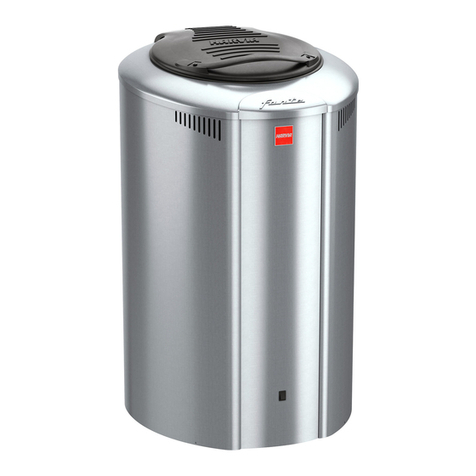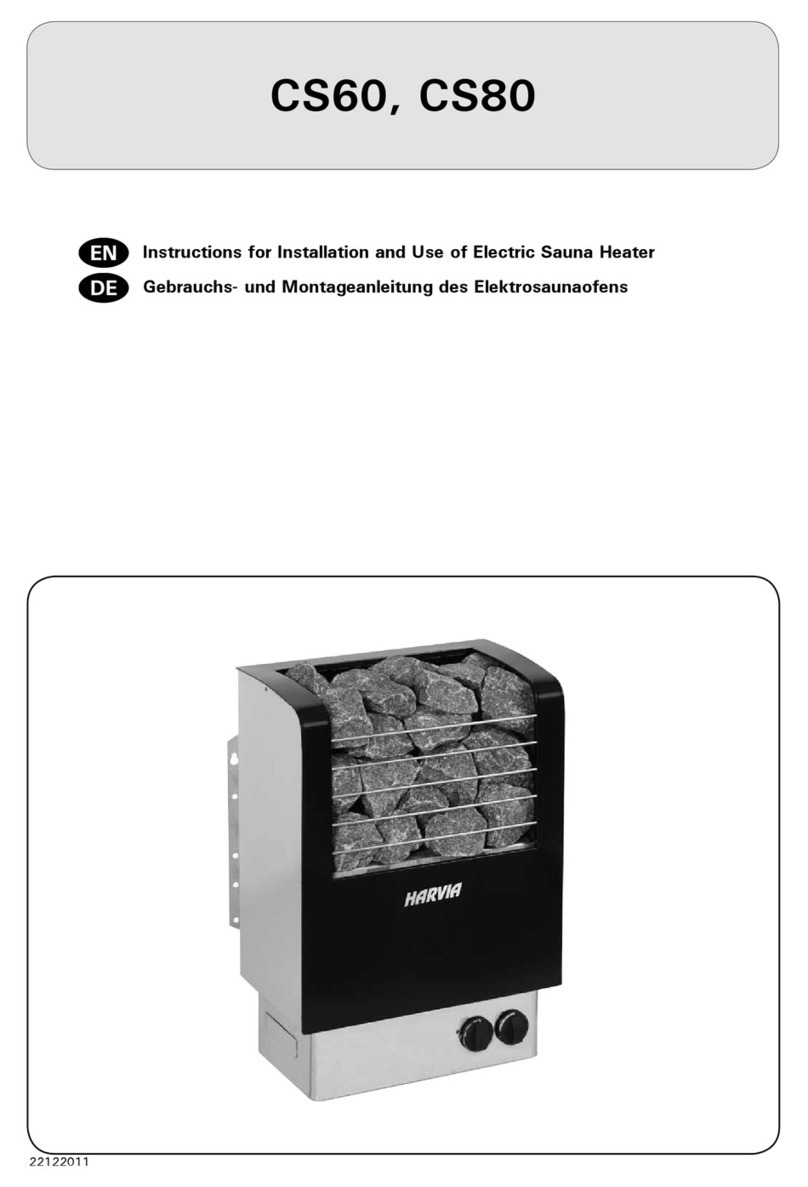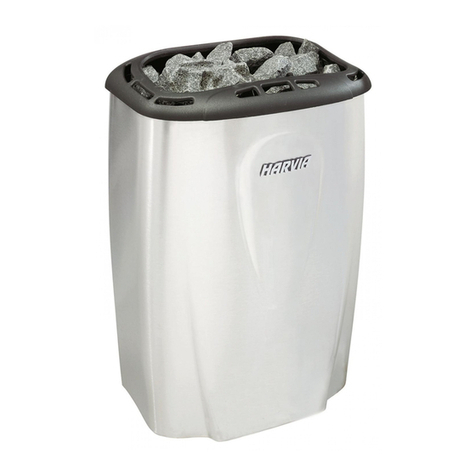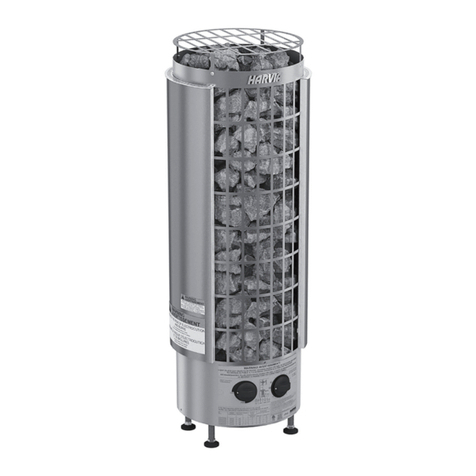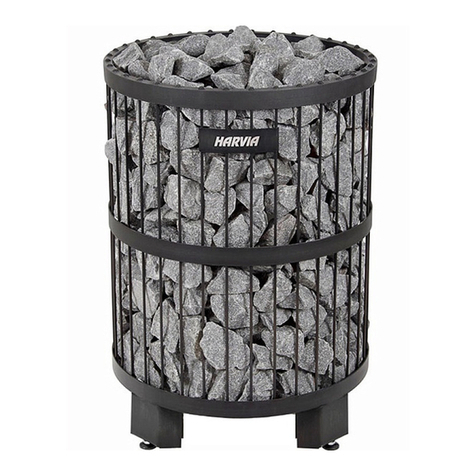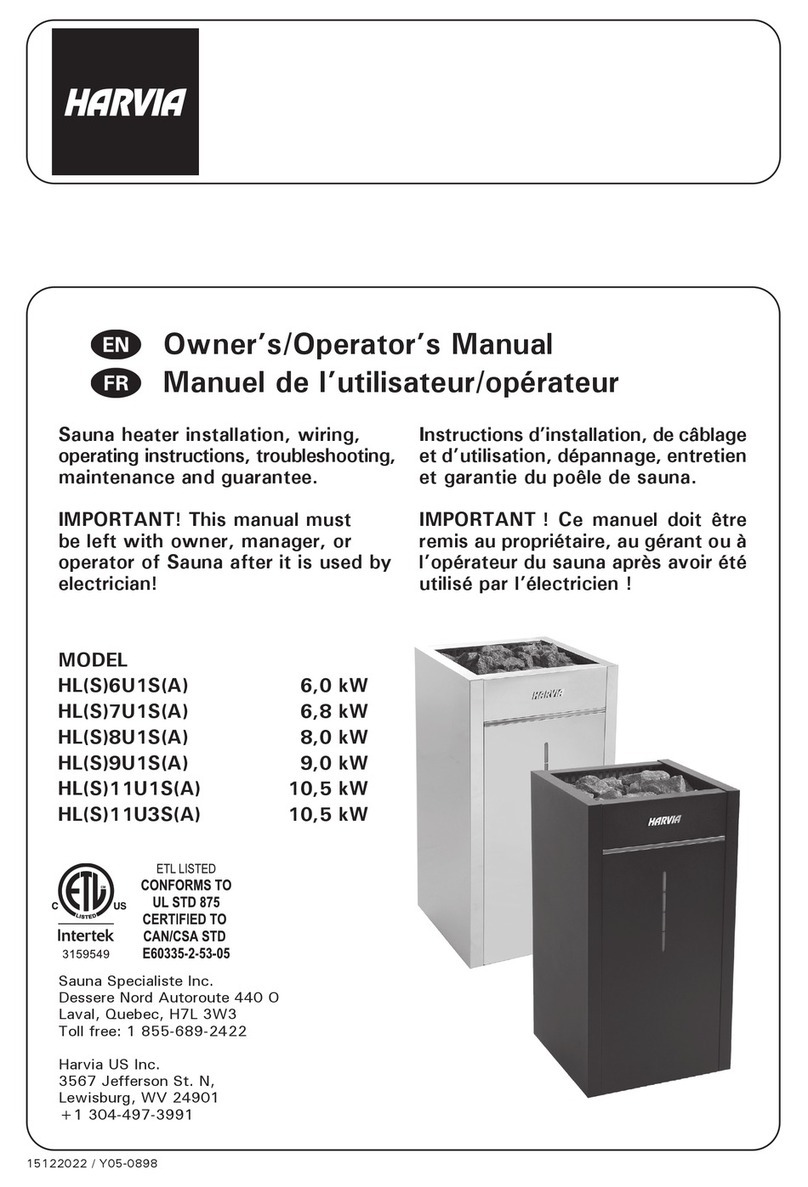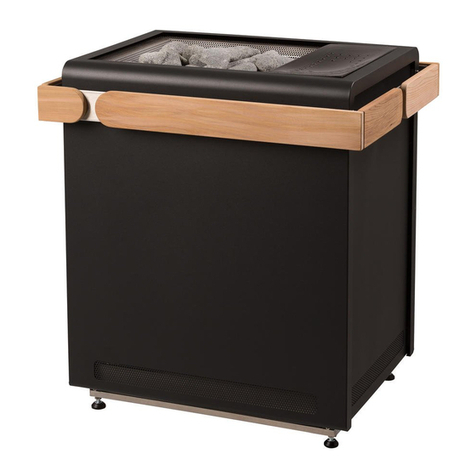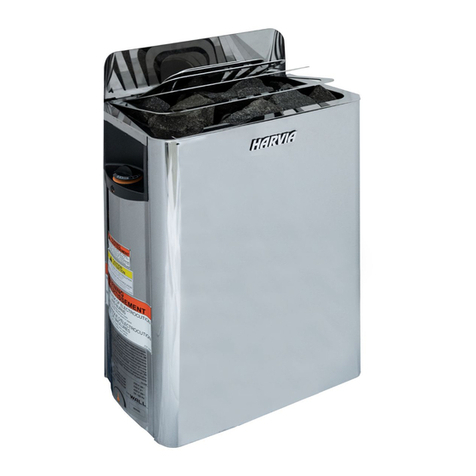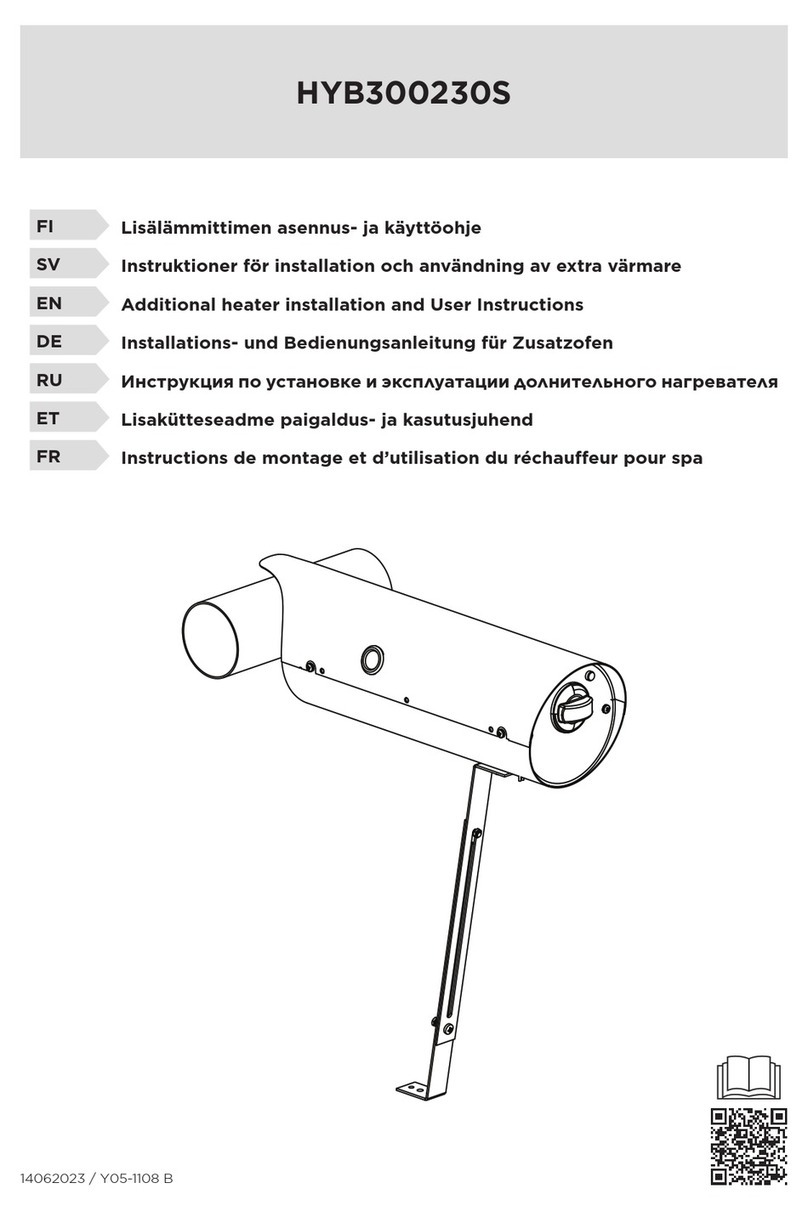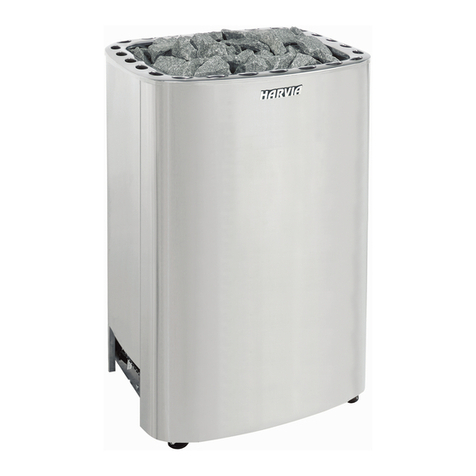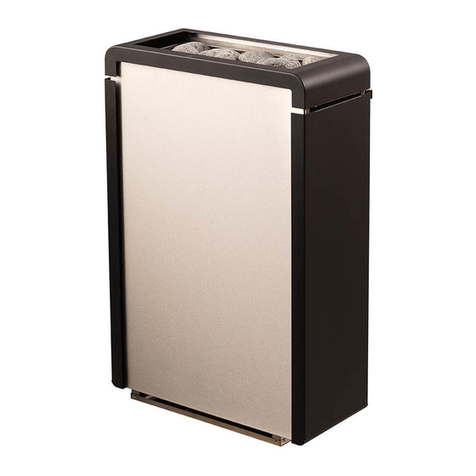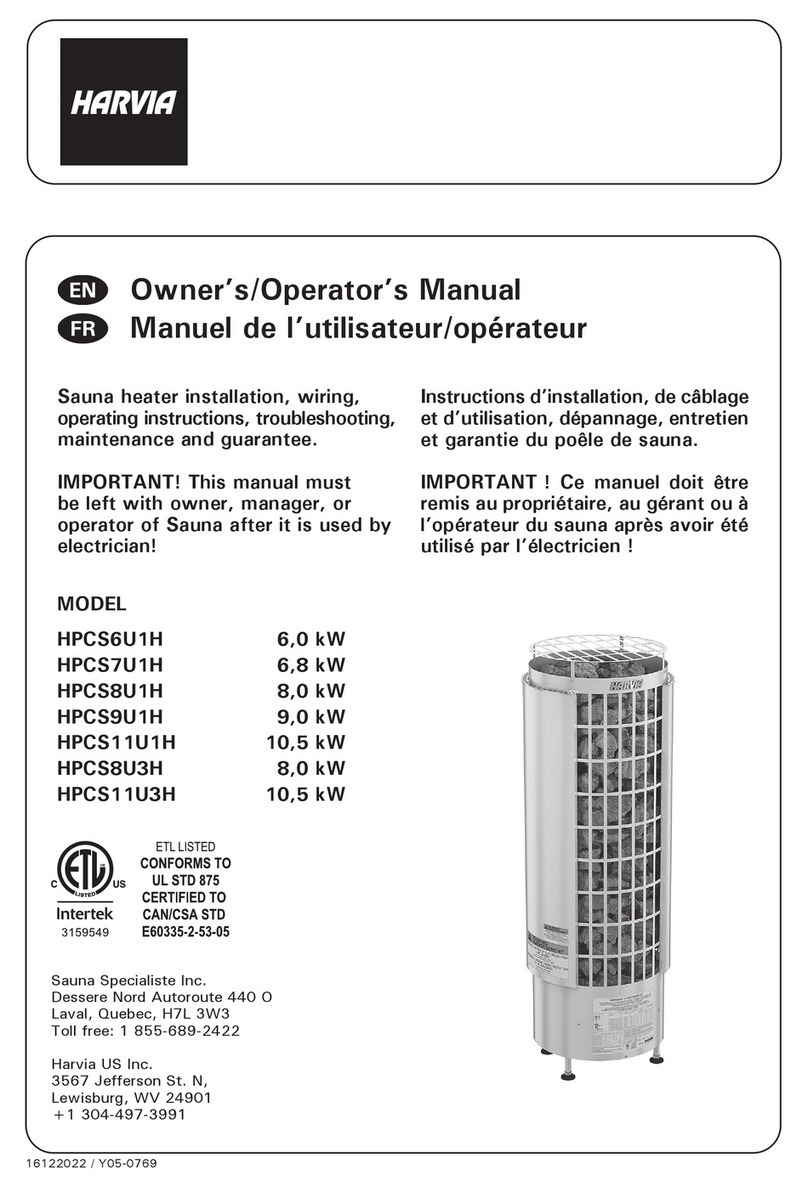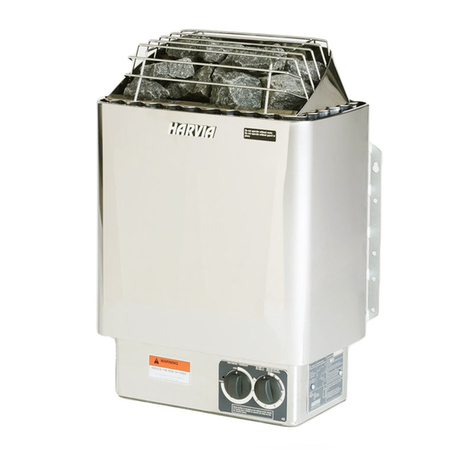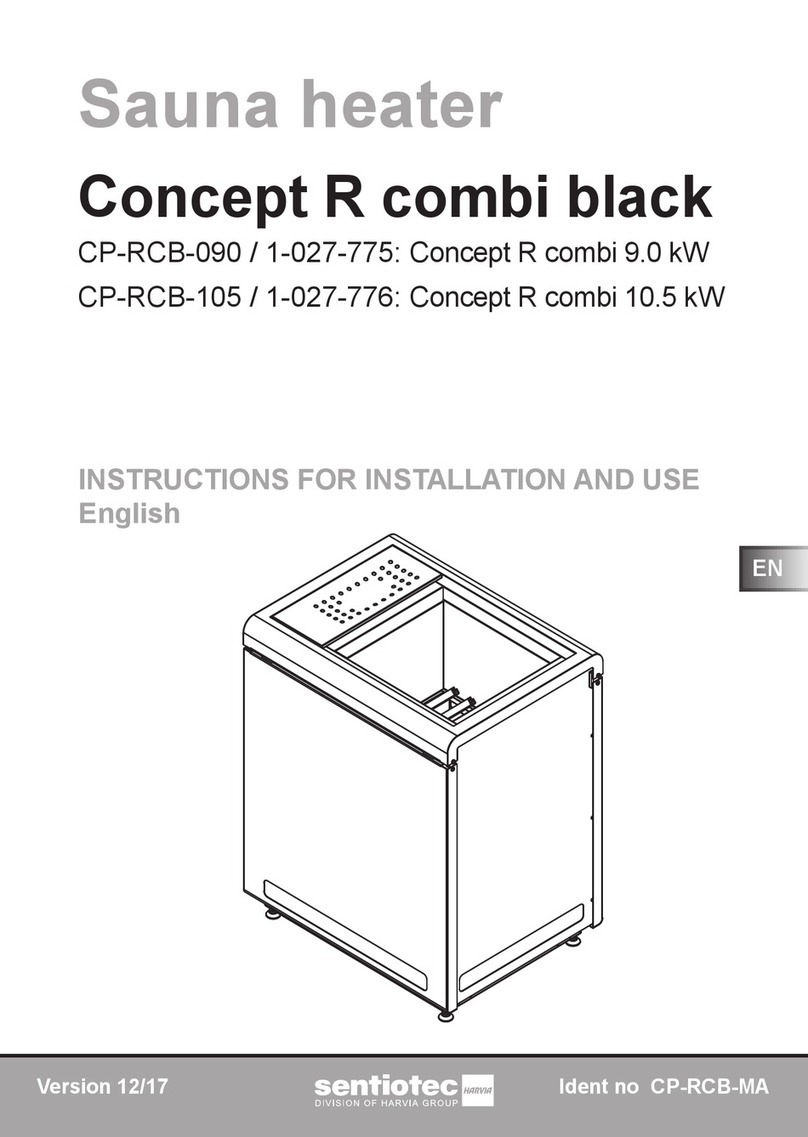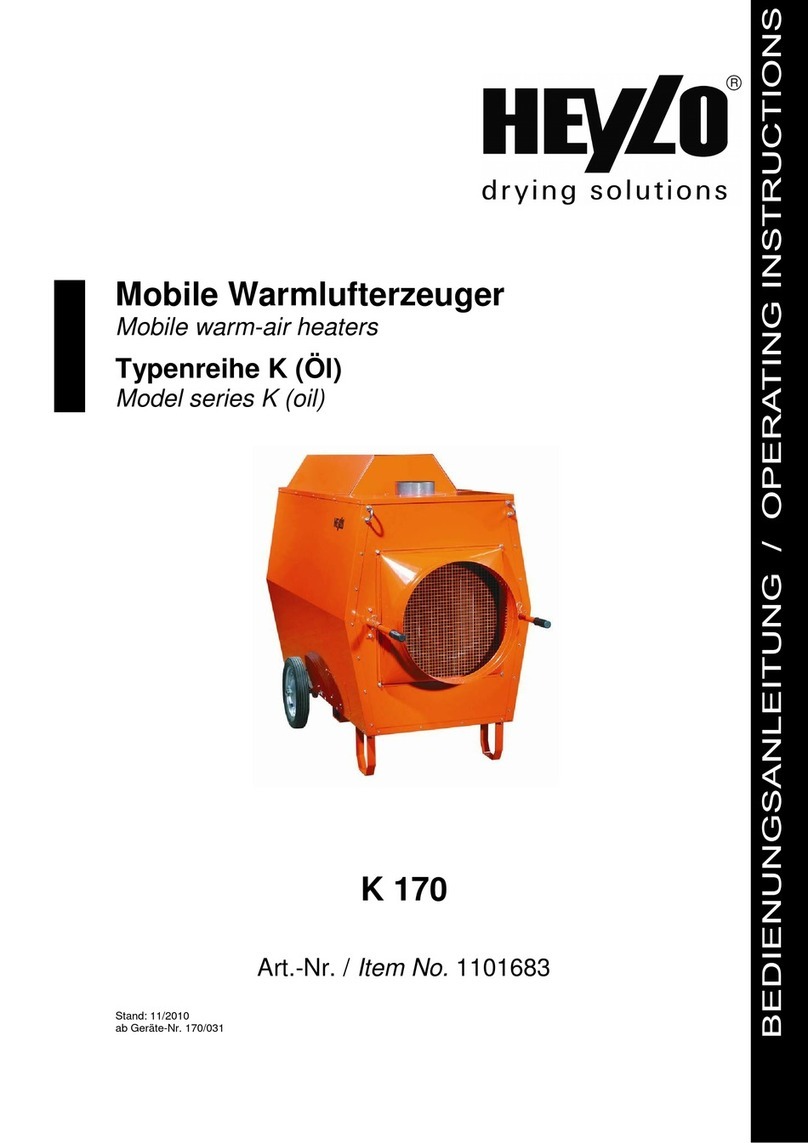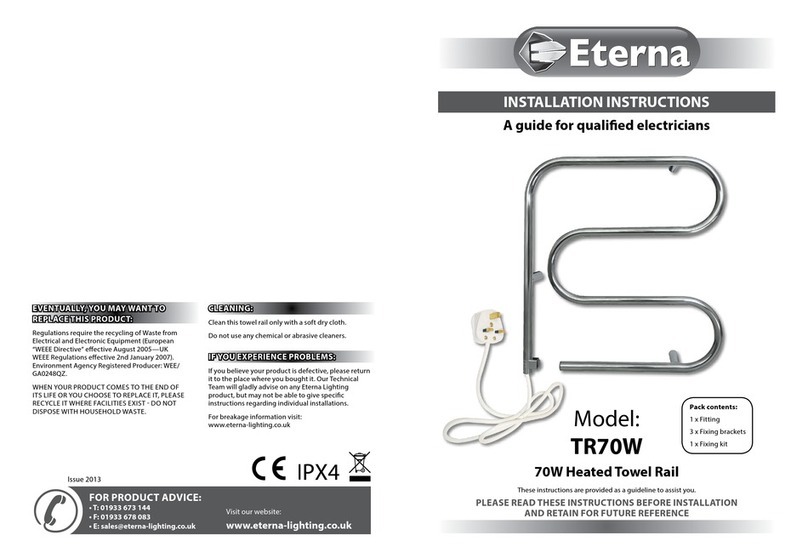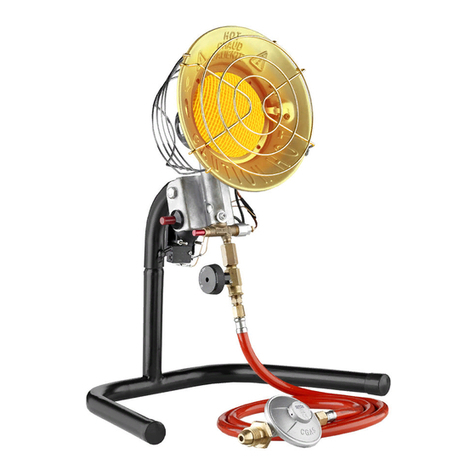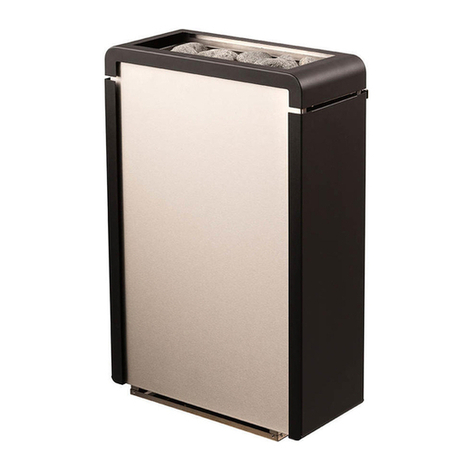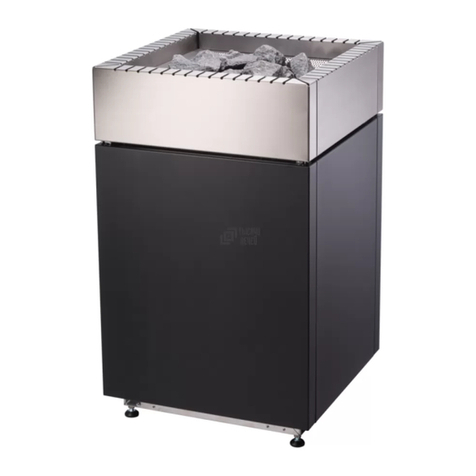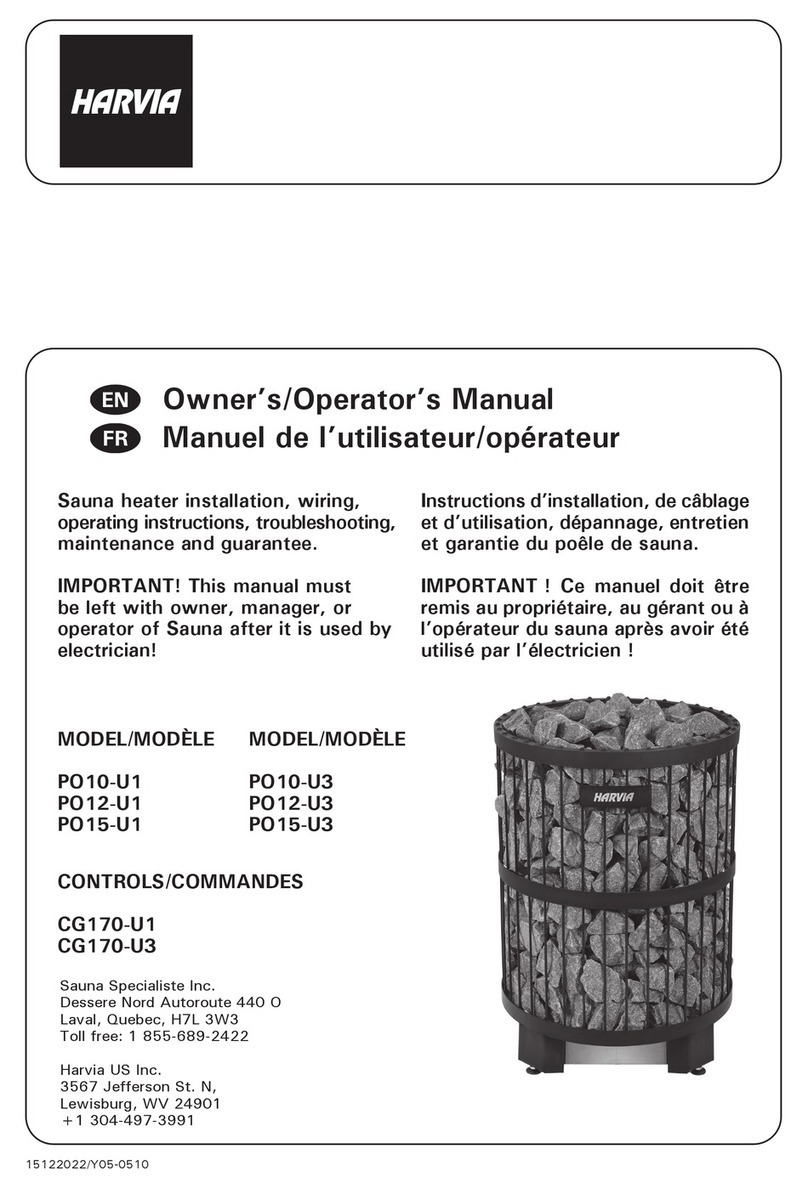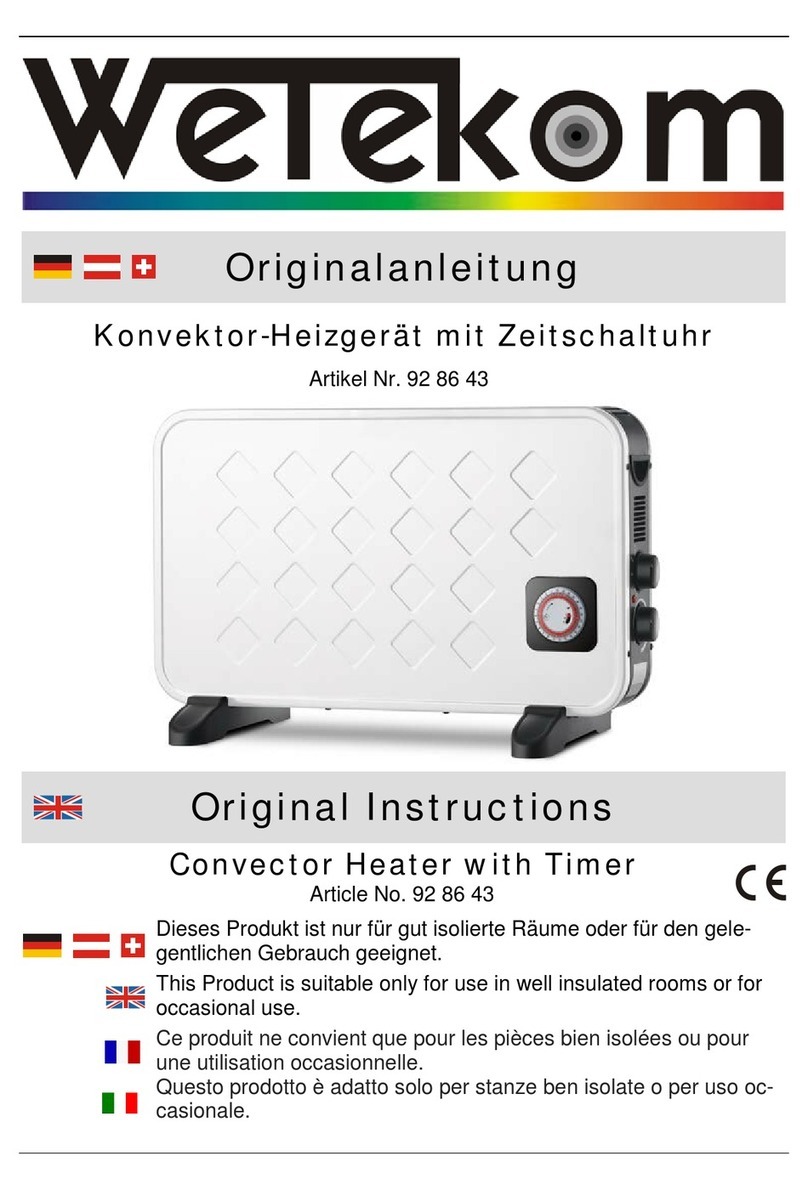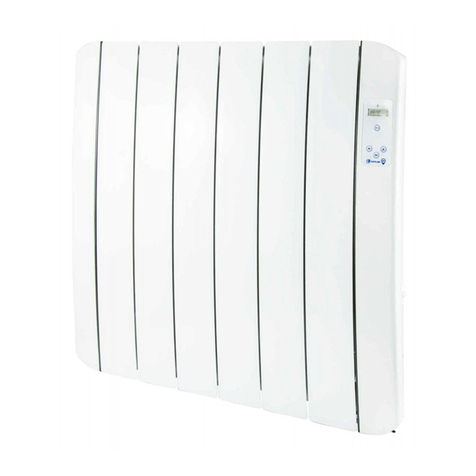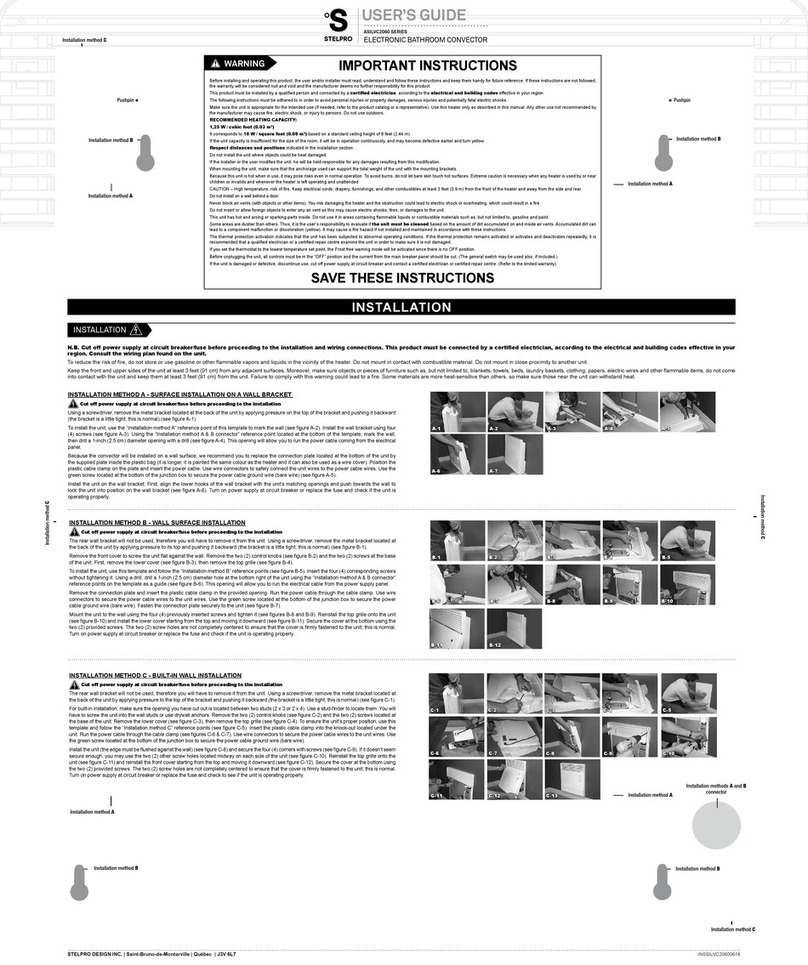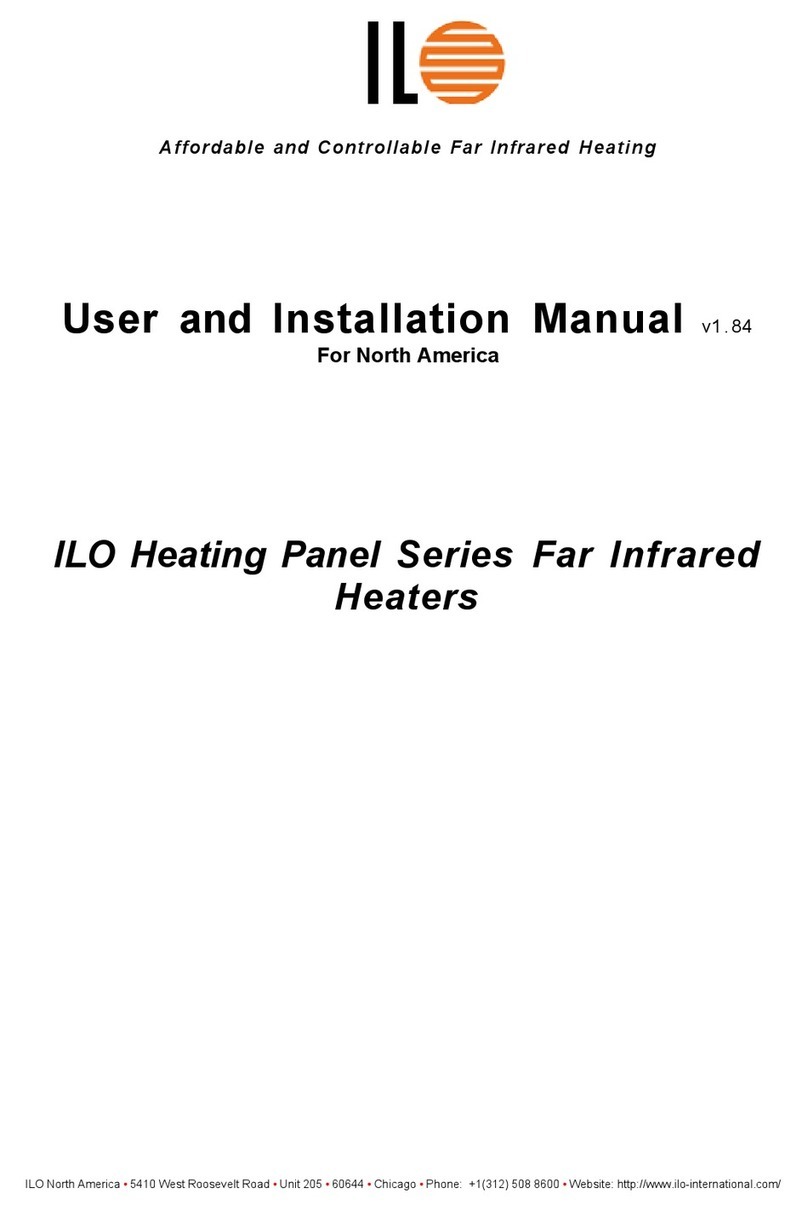
EN R
6
Piling of the Sauna Stones
The
sauna stones
for
anelectric
heater
should
be 4–8 cm in diameter.
The
heater stones should be solid blocks of
stone
specially
intended for use in the heater. Neither
light,
porous ceramic
“stones“
of the same size nor
soft
potstones should be used in the heater, because
they
may cause the resistance temperature to rise too
high
as
a
result of which the resistance may be
broken.
Stone dust should be washed off before piling
the
stones. The stones should be piled into the
stone
compartment
over the grating, between the
heating
elements (resistances) so that the stones
support
each other. The weight of the stones should not
lie
on the heating
elements.
The stones should not be piled too
tightly,
so
that
air can flow through the heater. The stones
should
be fitted loosely, and not wedged between
the
heating elements. Very small stones should not be
put into the heater at
all.
The stones should completely cover the
heating
elements. However, they should not form a high
pile
on the
elements.
The stones disintegrate with use. Therefore,
they
should be rearranged at least once a year or
even
more often if the sauna is in frequent use. At
the
same time, any pieces of stones should be
removed
from the bottom of the heater, and
disintegrated
stones should be replaced with new
ones.
The guarantee does not cover any faults caused
by
the use of stones not recommended by the
plant.
Neither does the guarantee cover any faults
caused
by disintegrated or too small stones blocking
the
heater
ventilation.
No such objects or devices should be placed
inside
the heater stone space or near the heater that
could
change the amount or direction of the air
flowing
through the heater, thus causing the
resistance
temperature to rise too high, which may set the
wall
surfaces on
fire!
Sauna
Water
The
water to be thrown
on
the
heated
stones should
meet
the requirements of clean household water. The
factors
essentially
affecting
the quality of water include
the
following:
•
humuos content (colour, taste,
precipitates);
recommended content less than 12
mg/litre.
•
iron content (colour, smell, taste,
precipitates);
recommended content less than 0,2
mg/litre.
•
hardness - the most important substances are
manganese (Mn) and calcium
(Ca);
recommended content of manganese 0,05
mg/
litre, calcium less than 100
mg/litre.
Calcareous water leaves a white, sticky layer
on
the stones and metal surfaces of the
heater.
Calcification of the stones deteriorates the
heating
properties.
Ferrous water leaves a rusty layer on the
surface
of the heater and elements, and causes
corrosion.
The use of humous, chlorinated water and
seawater
is
forbidden.
Amplasarea pietrelor de sauna
Pietrele de sauna pentru un incalzitor electric ar trebui
săfie 4-8 cm diametru. Pietrele încălzitorului ar trebui
săfie blocuri solide de piatrăspecial destinate utilizării
încălzitorului. Nici usoare, "pietre" ceramice poroase,
de aceeaşi dimensiune şi nici lutul moale nu ar trebui
săfie utilizat cu incalzitorul, deoarece acestea pot
provoca cresterea prea mare a temperaturii din
rezistenţa, ca urmare se poate deteriora.
Piatra ar trebui spalata de praf înainte de amplasarea
lor. Pietrele ar trebui săfie îngrămădite în
compartimentul de piatra peste gratar, între
elementele de încălzire (rezistenţă), astfel ca pietrele
sa se sprijine reciproc. Greutatea pietrelor nu trebuie
săstea pe elementele de încălzire.
Pietrele nu ar trebui săfie ingramadite prea strans,
astfel incat aerul sa poata circula prin sistemul de
încălzire. Pietrele ar trebui săfie montate slab, şi nu
prinse între elementele de încălzire. Pietre foarte mici
nu ar trebui săfie puse în încălzitor deloc.
Pietrele ar trebui săacopere complet elementele de
încălzire. Cu toate acestea, ele nu trebuie săconstituie
o gramada prea mare pe elementele de incalzire.
Pietrele se dezintegreaza in timp. Prin urmare,
acestea ar trebui săfie rearanjate cel puţin o datăpe
an sau chiar mai des dacăsauna este în uz frecvent.
În acelaşi timp, orice bucăţi de pietre ar trebui săfie
eliminate din partea de jos a încălzitorului , iar cele
dezintegrate ar trebui săfie înlocuite cu altele noi.
Garanţia nu acoperăorice defecţiuni cauzate de
utilizarea de pietre ce nu sunt recomandate la
instalatie. Garanţia nu acoperănici defecţiunile
cauzate de pietre care s-au dezintegrat sau sunt prea
mici ce blocheaza ventilaţia încălzitorului.
Nici astfel de obiecte sau dispozitive nu ar trebui săfie
plasate în interiorul spaţiului de piatrăa încălzitorului
sau în apropierea încălzitorului care ar putea schimba
cantitatea sau direcţia de circulare a aerului
prin încălzire independentă, cauzand astfel cresterea
prea mare a temperaturii rezistentei, care pot aprinde
suprafeţele de perete!
Apa pentru sauna
Apa care urmeazăsăfie aruncata pe pietrele
încălzite trebuie săîndeplineascăcerinţele de apă
curatăpentru uz casnic. Factorii care afectează, în
esenţă, calitatea apei includ următoarele:
• conţinut humuos (culoare, gust, precipită);
Conţinutul recomandat mai puţin de 12 mg / litru.
• conţinut de fier (culoare, miros, gust, precipită);
recomandat un conţinut mai mic de 0,2 mg / litru.
• duritatea - substanţele cele mai importante sunt
mangan (Mn) şi calciu (Ca);
Conţinutul recomandat de mangan 0,05 mg / litru,
de calciu mai puţin de 100 mg / litru. Apa calcaroasa
lasăun strat alb, lipicios pe pietre şi suprafeţele de
metal a încălzitorului. Calcificarea pietrelor
deterioreazăproprietăţile de încălzire. Apa feroasa
lasa un strat ruginiu pe suprafaţa încălzitorului şi pe
elementele de incalzire si cauzeaza coroziune.
Utilizarea apăhumousa, clorinata si apa de mare
este interzisa.
